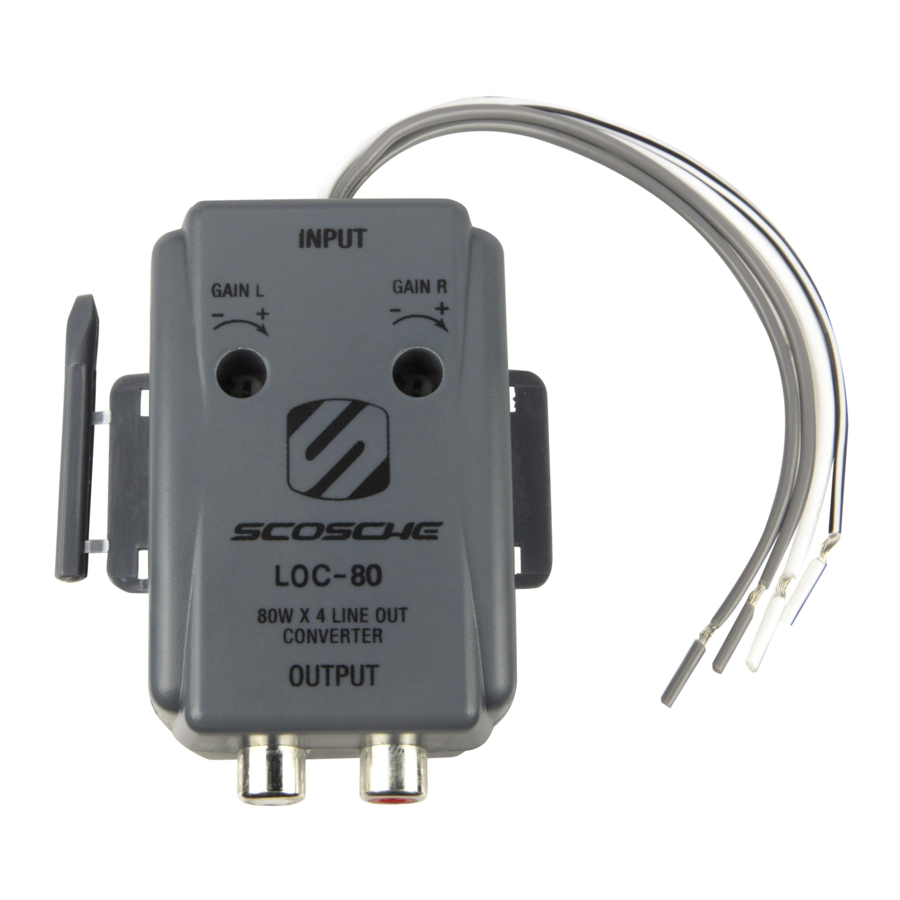
Advertisement

Introduction
The LOC-80 is a non-electronic device that allows any stereo to be connected to an amplifier/EQ booster. This is accomplished by converting the speaker high level outputs of any stereo into low level RCA jacks by electronically converting the signal as it passed through the LOC-80.
Use the LOC-80 whenever you wish to add an amplifier or EQ booster to a stereo that is not equipped with RCA (low-level) outputs. By simply connecting the speaker inputs of the LOC-80 to the speaker outputs of your radio, you can now add any amplifier or EQ booster to your car audio system. (See Illustration A).
ILLUSTRATION A:

DIRECTIONS - HELPFUL HINTS
- The wiring colors of the LOC-80 may be different from the wiring colors found on your stereo.
- Consult your stereo owner's manual to determine the correct wire functions.
- Always work in an area with ample lighting.
- For helpful hints on connecting wires, see the section entitled "Professional Wiring Tips".
CONNECTING THE LOC-SO TO YOUR RADIO
- Connect the left (+) speaker wire of your stereo to the white wire of the LOC-80. Connect the left (-) speaker wire to the white/black wire of the LOC-80. Connect the right (+) speaker wire to the gray wire of the LOC-80. Connect the right (-) speaker wire to the gray/black wire of the LOC-80. (See Illustration A.)
- Connect the RCA output jacks of the LOC-80 to the RCA inputs of your amplifier/EQ booster. Red = Right, White = Left.
- Check all connections and test the sound system.
ADJUSTING THE OUTPUT LEVEL
The LOC-80 is equipped with output level controls that can be adjusted for proper sound level matching. This is done by inserting a small flat blade or Phillips head screwdriver into the gain adjustment holes, located on top of the LOC-80. By turning clockwise, the gain for that individual channel, or the amount of sound allowed to pass through the LOC-80 is increased. By tuming counterclockwise, the gain for that individual channel is decreased. If you feel that after increasing the volume of your stereo, the sound is too quiet, then equally increase both the left and right gains of the LOC-80 until the sound level is adequate. If the sound level is too loud with only a slight increase in stereo volume, or distortion (poor sound quality) is notipeable, then equally decrease the gains of the LOC-80.
PROFESSIONAL WIRING TIPS
Never work with more than one connection at a time, as doing so may cause an electrical short circuit if two incompatible wires are allowed to touch.
Note: Soldering all wiring connections is recommended over simply twisting and taping connections. However, if a soldering iron is not available, butt connectors or wire nuts are recommended.
Soldering Wires: Strip back wire ends approximately 1/2" each. If using shrink tUbing to protect your connection, slip a 1" section to be used later over one of the wires.
Twist wire ends together. Begin by heating the bare wires with a soldering iron. Then apply the solder until it is absorbed into the strands of the wire. Allow wires to cool and solder to harden. Once cool, cover the connection with heat shrink tubing if used previously, or a UL approved electrical tape. Then move on to the next connection.
Butt Connectors: Strip back wire ends approx. 1/4 to 3/8" each. Crimp one end of the butt connector to one of the wires you wish to splice. Crimp the other end of the butt connector to the wire you wish to splice it to. Test crimp by gently tugging on both wires.
Wire Nuts: Twist together both ends of the wires you wish to connect. Slip the wire nut over the wire ends and twist until it is firmly seated over the wire ends. Test the connection by gently tugging the wires.



Documents / ResourcesDownload manual
Here you can download full pdf version of manual, it may contain additional safety instructions, warranty information, FCC rules, etc.
Advertisement



Need help?
Do you have a question about the LOC-80 and is the answer not in the manual?
Questions and answers